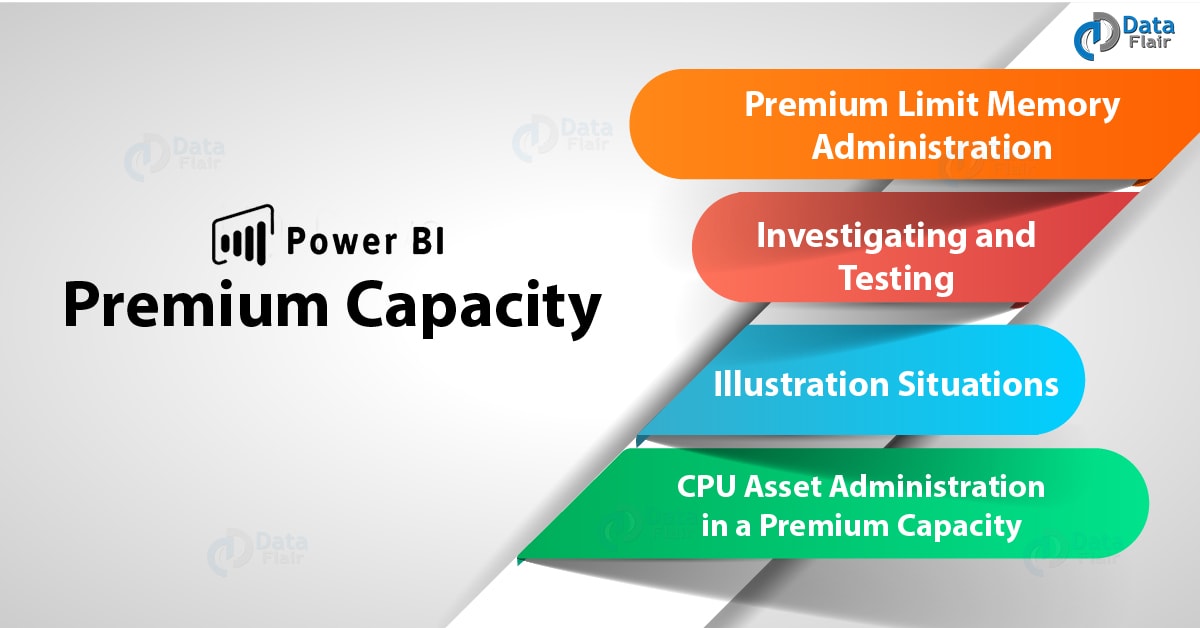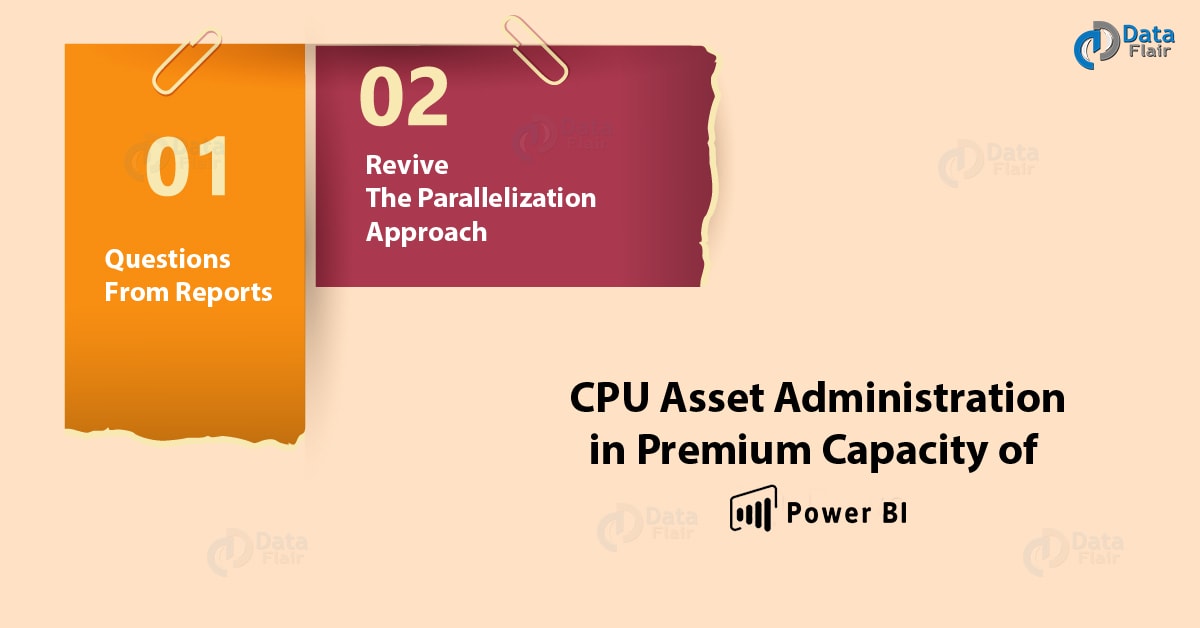Power BI Premium Capacity – Resource Management & Optimization
FREE Online Courses: Elevate Your Skills, Zero Cost Attached - Enroll Now!
1. Objective
In our previous session, we discussed Power BI Free vs Pro (Paid). Here, we will explore the Power BI Premium Capacity Tutorial. Moreover, we will study the memory administration and CPU Asset Administration (resources management). Along with this, we will learn illustration situations and troubleshooting and testing.
So, let’s start Power BI Premium Capacity Tutorial.
2. Power BI Premium Capacity
Power BI Premium gives assets devoted to running the Power BI benefit for your association or group, giving you more tried and true execution and bigger information volumes. Premium additionally empowers across the board appropriation of substance without expecting you to buy per-client licenses for watchers.
You can exploit Power BI Premium by doling out workspaces to a Premium limit. A Power BI Premium capacity is a committed asset for your association. For workspaces that not allowed to an exceptional limit, these will in a common capacity of Power BI Premium.
Do you know what is Power BI Data Modeling?
A shared capacity is an experience you utilize with Power BI, where your workloads keep running on computational assets shared by different clients. The shared limit, more points of confinement are put on singular clients to guarantee the nature of the experience for all clients.
3. Power BI Premium Capacity – Memory Administration
Power BI Premium capacity memory is devoured by:
a. Memory Utilized by Report Inquiries
At the point when a demand is issued against a distributed dataset in your ability, that dataset is stacked into memory from steady stockpiling (this is additionally called picture stack). Keeping the dataset stacked in memory encourages quick reaction to future questions to this dataset.
Notwithstanding the memory required for keeping the dataset stacked in the memory, report inquiries and dataset invigorates likewise expend extra memory.
Let’s explore Power BI Admin Roles (Power BI Administration)
b. Dataset Memory Estimation
When endeavouring to stack a dataset into memory, Power BI gauges the measure of memory that dataset will require to finish the asked for summoning. Datasets in memory have a tendency to bigger in estimate when spare to circle. Amid invigorate of a dataset, memory limit requires no less than twofold the measure of memory than required when it is sitting out of gear.
c. Overcommitting Limit, Expulsion, and Reloading of Datasets
Power BI Premium capacity gives you the upside of overcommitting your ability. For instance, you can distribute more datasets than capacity memory can hold. On the off chance that the distributed datasets in your ability require more memory than can fit in the limit. A portion of the datasets will put away independently in an industrious stockpiling. The tireless stockpiling is a piece of 100 TBs stockpiling related to every one of your abilities.
Things being what they are, what datasets remain in memory and the end result for alternate datasets? As depicted before, when a demand issue against a dataset, it stackes into memory (picture stack). The ask for could a report inquiry or a revive task.
Since you can overcommit your ability, your ability may likewise confront memory weight. At the point when limit faces memory weight (on the grounds that another dataset should stack or the questions on some stacked datasets increment the memory prerequisite), the hub ousts at least one datasets involving the limit memory. Datasets that are idle (i.e. there is no question/revive activity as of now executing) expel first and the request of removal is in a ‘minimum as of late utilized’ (LRU) way. In the event that new orders issue to the removed dataset. The administration endeavours to reload this into memory, possibly ousting different datasets. This conduct takes into account more proficient use by enabling the ability to serve numerous more datasets than its memory can hold.
Stacking a dataset into memory is a genuinely expensive task. Contingent upon the dataset measure, it can last from several seconds for little datasets to many seconds or even minutes for huge datasets like ~10 GB datasets. A Power BI Premium capacity endeavours to limit the circumstances the limit should stack by keeping the slightest as of late utilized datasets in memory for whatever length of time that conceivable. At the point when extra memory requires, some datasets should out and the framework will endeavour to pick the one that has minimal effect on the client encounter.
Follow this link to know How to Share Power BI Dashboard with Outside Organization/Clients
At the point when extra memory requires, some datasets should expel and the framework will endeavour to pick the one that has minimal effect on the client encounter. For instance, the framework will abstain from ousting datasets which were effectively utilized inside the most recent couple of minutes, since they are probably going to question again soon.
The removal procedure itself is a quick task. On the off chance that the dataset isn’t in dynamic use at the season of ousting, the client won’t have the capacity to decide much effect from the expulsion. Notwithstanding, if excessively numerous datasets are in dynamic use in the meantime and there isn’t sufficient memory to hold them every one of them, a considerable measure of expulsions can happen. This can prompt a ‘whipping’ circumstance, where datasets are always removing and re-stacked, and clients could see a detectable drop accordingly times and execution.
d. Dataset Revive Memory Necessity Contending
Datasets can revive on a timetable or on-request by clients. As portrayed before, the memory required for full revives no less than twofold the memory size of the stacked and sit still datasets. Before reviving begins, an invigorate memory prerequisite asses. On the off chance that the aggregate memory prerequisite is more than the accessible memory in the limit, some datasets are ousted. Contender for ousting picked in the request of slightest as of late utilized datasets. Benefit attempts to keep whatever number as of late utilized datasets as could expect under the circumstances in the memory.
On the off chance that the required memory isn’t accessible regardless of expulsion, the revive line up to retry. The administration retries until the point when it succeeds or another invigorate activity starts.
In the event that an intuitive question issue to any dataset in the limit and there isn’t sufficient memory accessible on account of a continuous invigorate. That demand fizzles and should retry by the client.
Read about Basic Area Chart in Power BI
4. CPU Asset Administration in Premium Capacity of Power BI
There are two essential shoppers of CPU assets:
- Questions from reports
- Revive (handling)
a. Questions from Reports
Report questions devour CPU assets of your ability. In the event that your report has a few questions that are wasteful or in the event that you have numerous simultaneous clients. It can expend a considerable measure of CPU assets and your current limit may not adequate to deal with the heap.
b. Revive the Parallelization Approach
Memory isn’t the main asset that can oblige invigorating of datasets. The number of v-centres on a server can likewise a factor. Since each revive task requires a specific number of v-cores. There is a constraint regarding what number of invigorates can keep running in parallel. The breaking point per SKU is nitty gritty in the accompanying table. Extra invigorates that go past these points of confinement will line.
Let’s revise How to Connect to Data in Power BI Desktop
| SKU | Backend V-Cores | Model refresh parallelism |
| A1 | 0.5 | 1 |
| A2 | 1 | 2 |
| A3 | 2 | 3 |
| A4 | 4 | 6 |
| A5 | 8 | 12 |
| A6 | 16 | 24 |
| EM1 | 0.5 | 1 |
| EM2 | 1 | 2 |
| EM3 | 2 | 3 |
| P1 | 4 | 6 |
| P2 | 8 | 12 |
| P3 | 16 | 24 |
| P4 | 32 | 48 |
| P5 | 64 | 96 |
Tip – In the event that your revives are getting defer, check the quantity of parallel invigorates bolstered by your ability.
5. Illustration Situations
The accompanying depict some regular situations and the moves made by the administration:
Twenty planned invigorates presented all in the meantime. Power BI endeavours to begin the primary x revives in the meantime. The incentive for x dictates by the invigorate parallelization strategy for that SKU. In the event that Power BI can’t acquire enough memory by ousting latent, not all x invigorates will begin in the meantime. Any revive that can’t begin, line until the point when it can begin.
Two revives running in the meantime and there is sufficiently just memory for one to complete. The one that can complete begins. The other is retry later.
A huge number of datasets being questioned while a few datasets invigorate. If enough memory isn’t accessible, Power BI endeavours to stop dynamic revives to offer need to intelligent inquiries. This will diminish the invigorate execution.
Do you know How to Import Excel Workbooks into Power BI Desktop
Dataset requires excessive memory to invigorate on current limit estimate – Refresh will fall flat. No endeavours are made to get more memory by expulsion.
Reviving a solitary dataset which has an extensive spike in memory. If the spike is bigger than the measure of memory that can acquire by removing idle datasets. It Invigorates retry later until there is sufficient memory to deal with the spike.
Question execute for a dataset which can’t get enough memory by expelling all latent datasets and revives. Those inquiries come up short. For these sorts of workload necessities, higher limit ought to acquire.
6. Investigating and Testing
In the event that reports are moderate or lethargic, begin by testing for only one client on your report. At that point begin expanding the simultaneous client load to discover the farthest point. Much of the time, tuning your DAX can definitely change the execution of your reports.
Utilize Power BI Embedded limit in Azure to test diverse SKUs and decide the best Premium SKU for your normal workload. The Power BI Embedded A4 SKU is equivalent to the P1, A5 = P2 and A6 = P3. In Azure, you can undoubtedly switch between SKUs by scaling all over in the Azure entrance. When you discover the SKU that works best for your workload and finish trying, you can erase the SKU.
Now and again, opening a PBIX record of the model on your PC and checking memory and CPU utilization educates a considerable measure regarding the issue. This doesn’t help for huge models, yet for some little models. It has a go at opening, invigorating, and questioning the model from your PC. Check the model size, memory, and CPU expended when you open the model. Have a go at reviving and questioning. Utilize undertaking administrator to check CPU and Memory utilization for the nearby PBIX record). Some of the time, those measurements on your PC itself can tell that lower premium capacity like P1/P2 may not work for your answer.
So, this was all about Power BI Premium Capacity Tutorial. Hope you like our explanation.
7. Conclusion
Hence, in this Power BI Premium Capacity tutorial, we learned about Power BI Premium capacity resource management and optimization. Along with this, we discussed troubleshooting and testing. Furthermore, if you have any query regarding Power BI Premium Capacity, feel free to ask in the comment section.
Related Topic – Power BI Gateway
For reference
If you are Happy with DataFlair, do not forget to make us happy with your positive feedback on Google





Could you please share steps to Enable AI insight in Power BI services